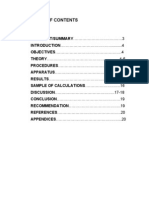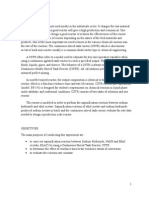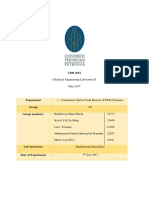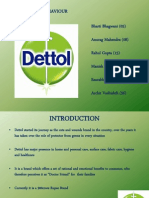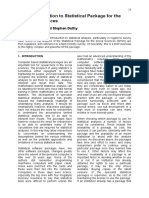Lab Manual
Lab Manual
Uploaded by
Aasia FarrukhCopyright:
Available Formats
Lab Manual
Lab Manual
Uploaded by
Aasia FarrukhOriginal Description:
Copyright
Available Formats
Share this document
Did you find this document useful?
Is this content inappropriate?
Copyright:
Available Formats
Lab Manual
Lab Manual
Uploaded by
Aasia FarrukhCopyright:
Available Formats
Department of Chemical Engineering
Wah Engineering College, Wah Cantt.
Chemical Reaction Engineering Lab Manual
INTRODUCTION:
In the majority of the chemical processes, the reactor vessel in which the process takes place is
the key item of equipment. The design of chemical reactors is therefore crucial to the success of
the industrial operation. In general, aim is to produce a specified product at a given rate using
known reactants. Various types of chemical reactor are used to achieve these obejctives namely
CSTRs, tubular reactors and batch reactors.
Chemical reaction laboratory is intended to introduce undergraduate students to the areas of
chemical reaction and reactor operation . The chemical reactors teaching equipment
demonstrates the characteristics of the important types of chemcial reactor, batch stirred tank
reactor , continuous stirred tank reactor and tubular reactor.
Department of Chemical Engineering
Wah Engineering College, Wah Cantt.
Chemical Reaction Engineering Lab Manual
List of Equipments
1. Batch Reactor
2. Continuous Stirred Tank Reactor
3. Tubular Reactor
4. Continuous Stirred Tank Reactors in Series
Department of Chemical Engineering
Wah Engineering College, Wah Cantt.
Chemical Reaction Engineering Lab Manual
Batch Reactor:
Batch reactor is the generic term for a type of vessel widely used in the process industries. Batch
reactor consists of a tank with an agitator and integral heating/cooling system. The advantages of
the batch reactor lie with its versatility. A single vessel can carry out a sequence of different
operations without the need to break containment. This is particularly useful when processing,
toxic or highly potent compounds.
Continuous Stirred Tank Reactor:
The continuous stirred tank reactor is designed to demonstrate the mechanism of chemical
reaction in the stirred reactor as well as the effects of varying process conditions such as reaction
temperature, reactor volume, stirring rate, feed rate etc.
Tubular Reactor:
Department of Chemical Engineering
Wah Engineering College, Wah Cantt.
Chemical Reaction Engineering Lab Manual
Tubular reactors are often used when operation without back-mixing is necessary. Often, they are
referred to as Plug Flow reactors from the description of the way the reactants move through the
tube.
This equipment is used to demonstrate the mechanism of a chemical reaction in such reactor as
well as the effects of process conditions. Reactions are monitored by conductivity probe as the
conductivity of the reacting solution changes with conversion of the reactants. This means that
the inaccurate and inconvenient process of titration, which was formally used to monitor the
reaction progress, is no longer necessary.
Department of Chemical Engineering
Wah Engineering College, Wah Cantt.
Chemical Reaction Engineering Lab Manual
SERVICE UNIT:
The chemical reactors service unit provides feed tanks, feed pumps, temperature control and
monitoring instrumentation for individual CSTR,tubular and batch reactors.
The service unit provides the following facilities
a. Storage of chemical reagents
A reagent tank module consists of two 5.0 litre capacity glass vessels mounted into a
PVC base which is located on studs. Drain valves are fitted to to the underside of each
reactor. Rigid standpipes are incorporated in the lids of the vessels to provide the suction
to the peristaltic reactor feed pumps. Flexible silicon piping is used to connect the
standpipies to pumps.
b. Variable throughput feed pumps
The peristaltic type pumps are capable of a throughput range of nominally 0-95 ml per
minute.
c. Variable speed agiatator control
d. Hot water circulator for operation of reactors at temperatures above ambient
e. Automatic temperature control of reactor contents
Department of Chemical Engineering
Wah Engineering College, Wah Cantt.
Chemical Reaction Engineering Lab Manual
NOMENCLATURE
a
sodium hydroxide conc. in feed vessel (mol/ dm3)
ao
sodium hydroxide conc. in mixed feeds (mol/ dm3)
al
sodium hydroxide conc. in reactor at time t (mol/ dm3)
sodium hydroxide conc. In reactor after infinite time (mol/dm3)
ethyl acetate conc. (mol/ dm3)
(same subscripts as above for a)
sodium acetate conc. (mol/ dm3)
(same subscripts as above for a)
total volume feed rate (dm3/s)
Fa
volume feed rate of sodium hydroxide. (dm3/s)
Fb
volume feed rate of ethyl acetate. (dm3/s)
specific rate constant
reaction rate
reactor temperature (K)
volume of reactor (dm3)
Xa conversion of sodium hydroxide = ao a1/ ao
Xc conversion of sodium acetate = Co Co/ C
Department of Chemical Engineering
Wah Engineering College, Wah Cantt.
Chemical Reaction Engineering Lab Manual
List of Experiments
. Experiment 1:
To find the reaction rate constant in a stirred batch reactor.
Experiment 2:
To determine the effect of reactant concentration on the reaction rate
Experiment 3:
To find the reaction rate constant in a Continuous stirred tank reactor.
Experiment 4:
To determine the effect of inadequate mixing on the reaction rate
Experiment 5:
To determine the rate constant using a tubular reactor
Experiment 6:
To demonstrate the temperature dependence of the reaction and the rate
constant.
Experiment 7:
To investigate the effect of throughput on conversion.
Experiment 8:
Department of Chemical Engineering
Wah Engineering College, Wah Cantt.
Chemical Reaction Engineering Lab Manual
Demonstration of the progress of a second order chemical reaction through
three continuous stirred tank reactors in series
EXPERIMENT 1:
To find the reaction rate constant in a stirred batch reactor.
Reaction:
NaOH+CH3COOC2H5
CH3COONa+C2H5OH
Assuming that the initial concentrations are equal and that the converted concentration is X then
the final concentrations are
NaOH+CH3COOC2H5
a-X
a-X
CH3COONa+C2H5OH
X
From the kinetic analysis of a general second order reaction it can be shown that
k . t=
X
a(aX )
Where k is the reaction rate constant and t is the time of reaction.
PROCEDURE:
Make up 1 litre batches of 0.05 M of sodium hydroxide and 0.05 M ethyl acetate.
Adjust the set point of the temperature controller to 15 deg C.
Charge the batch reactor with 0.5 litres of of sodium hyroxide solution.
Department of Chemical Engineering
Wah Engineering College, Wah Cantt.
Chemical Reaction Engineering Lab Manual
Switch on the reactor agitator and adjsut the speed setting to 7.0.
The experiment involves the storage and collection of conductivity data, the data output
port must be connected to data logger interface. This will enable data logging of the
conductivity at selected time intervals over a selected period. If computer is not available,
conductivity can be recorded manually at different time intervals by reading the value
directly from the conductivity meter in the console.
Collection of data will be until a steady state condition is reached in the reactor and this
takes approximately 30 minutes.
Switch on the chilled water circulator.
Carefully add to the reactor 0.5 litres of ethyl acetate solution and begin taking readings
of conductivity.
It has been deteermined that the degree of conversion of reagents affects the conductivity of the
reactor contents so that the readings of conductivity can be used to calculate the amount of
conversion.
INTERPRETATION OF RESULTS:
The conductivity measurements must now be translated into degree of conversion of the
constituents.
Both sodium hydroxide and sodium acetate contribute conductance to the reaction solution while
ethyl acetate and ethyl alcohol do not. The conductivity of a sdoium hydroxide solution at a
given concentration and temperature is not same as that of a sodium acetate solution at the same
molarity and temperature and a relationship has been established allowing conversion to be
inferred from conductivity.
a 1=( aao )
Xa=
aoa 1
ao
o 1
+ao
o
Department of Chemical Engineering
Wah Engineering College, Wah Cantt.
Chemical Reaction Engineering Lab Manual
To calulate the specific rate constant k, plot a graph of Xa and time. The slope of the graph will
be rate constant.
EXPERIMENT 2:
To determine the effect of reactant concentration on the reaction rate.
THEORY:
In homogenous reaction systems, reaction rates depend on the concentration of reactants.
Collision theory indicate a rate increase if the concentartion of one or both of the reactants is
increased. However, the specific effect of concentration changes in a reaction system has to be
determined by experimental methods. Increasing the concentration of substance A in recation
with substance B could increase the reaction rate, decrease it or have no effect on it.
The general form of the rate law is
R=k [ A ]n [B ]m
Where R = reaction rate , k = rate constant
n
[ A ] [ B]
= molar concentration of reactants
n, m= approximate powers based on experimental data.
PROCEDURE:
Department of Chemical Engineering
Wah Engineering College, Wah Cantt.
Chemical Reaction Engineering Lab Manual
The same procedure as for experiment 1. Run the experiment using different initial
concentrations of the reagents. For example, 0.1 M, 0.08 M and 0.02 M (0.5 liter of each
solution will be required for each mixture tested).
Graphs can be plotted relating reaction rate to concentration level for each of the
reactants tested.
A logarithmic plot of reaction rate to concentration level will give a straight line of slope
equal to power of relationship.
Hence write the rate law for sodium hydroxide and ethyl acetate in the form
n
R=k [ A ] [B ]
EXPERIMENT 3:
To find the reaction rate constant in a Continuous stirred tank reactor.
THEORY:
The reaction
NaOH+CH3COOC2H5
CH3COONa+C2H5OH
can be considered equimolar and first order with respect to both sodium hydroxide and ethyl
acetate i.e. second order overall within the limits of concentration (0-0.1 M) and temperature
(20-40 deg C) studied.
The reaction carried out in CSTR or tubular reactor eventually reaches steady state when a
certain amount of conversion of the starting reagents has taken place.
The steady state conditions will vary depending on concentration of reagents, flowrate, volume
of reactor and temperature of reaction.
PROCEDURE:
Department of Chemical Engineering
Wah Engineering College, Wah Cantt.
Chemical Reaction Engineering Lab Manual
Make up 5.0 litre batches of 0.1 M sodium hydroxide and 0.1 M ethly acetate.
Remove the lids of the reagent vessels and carefully fill with the reagents to a level
approximately 50 mm from the top. Refit the lids.
Adjust the set point of the temperature controller to 30 deg C.
Collection of conductivity data will be until a steady state condition is reached in the
reactor and this takes approximately 30 minutes. It is advisable to set the data collection
period to say 45 minutes.
Using the calibration graph for each of the feed pumps, set the pump speed control to
give 40ml/min flowrate.
Set the agitator speed controller to 7.0
Switch on both feed pumps and the agitator motor, and begin taking readings.
After a few minutes, the temperature sensor tip will be covered.
Switch on the hot water circulator.
It has been determined that the degree of conversion of the reagents affects the conductivity of
the recator contents so that recording the conductivity with respect to time can be used to
calcualte the amount of conversion.
INTERPRETATION OF RESULTS:
Record the conductivity of the contents of the reactor over the period of the reaction, the
conductivity measurements must now be translated into degree of conversion of the constituents.
Enter the following known constants
Fa=
Fb=
a=
b=
c=
T=
Department of Chemical Engineering
Wah Engineering College, Wah Cantt.
Chemical Reaction Engineering Lab Manual
V=
Calculate the following values.
ao=
Fa
.a
Fa+ Fb
bo=
Fa
.b
Fa+ Fb
Covert the readings of conductivity into concentrations
a 1=( aao )
c 1=c
o 1
+ao
o
o 1
o
a1 is value of sodium hydroxide concentration and c1 is sodium acetate concentrtaion and
degree of conversion are Xa and Xc.
Xa=
aoa 1
ao
Xc=
c1
c
To calulate specific rate constant k:
1
)
( ( Fa+V Fb ) ).( aoa
a1
k=
Department of Chemical Engineering
Wah Engineering College, Wah Cantt.
Chemical Reaction Engineering Lab Manual
EXPERIMENT 4:
To determine the effect of inadequate mixing on the reaction rate.
THEORY:
The rate of recation is measured by the amount of reactants converted to products in a unit of
time. In order for reaction to occur,particle smust come into contact and this contact msut result
in interaction. The rate of reaction depends on the collision frequency and collision efficiency of
particles of reacting substances. These factors are optimised by thorough mixing of the reactants
using stirrers and baffles within the reactor. Inefficient mixing will result in reduced reaction
rates.
Consideirng the reaction between sodium hydorixde ad ethyl acetate, if the initial concentration
are equal then concentrations are
Department of Chemical Engineering
Wah Engineering College, Wah Cantt.
NaOH+CH3COOC2H5
(ao-X a)
Chemical Reaction Engineering Lab Manual
CH3COONa+C2H5OH
(ao-Xa)
Xa
Xa
PROCEDURE:
Repeat the experiment 1 after removing the baffles from the reactor. This is achieved by
removing the conductivity and temerature probes then removing the lid of the reactor.
The baffle arrangement simply lifts out.
Repeat the expeiment 1 with baffles removed and no stirring action
Graphs of the reaction conversion with time can be plotted using the manual readings of
conductivity obtained.
Comment on the results obtained
EXPERIMENT 5:
To determine the rate constant using a tubular reactor.
THEORY:
The rate expression can be shown to be r=k.a.b
Where if a is equal to b this simplifies to r=k.a2
In the genral case, the order of the reactionn is not known and is shown by r=k.an
The rate constant can be determined using tubular reactor. For a second order reaction
k . t . a =
Xa
1Xa
Department of Chemical Engineering
Wah Engineering College, Wah Cantt.
From this equation it can be seen that a plot of
of slope k.
Chemical Reaction Engineering Lab Manual
Xa
1Xa
against t will give a straight line
If the inlet concentration
is known, k can be determined.
The reaction
NaOH+CH3COOC2H5
CH3COONa+C2H5OH
can be considered equimolar and first order with respect to both reactants.
PROCEDURE:
Make up 5.0 litre batches of 0.05 M sodium hydroxide and 0.05 M ethyl acetate.
Remove the lids of the reagent vessels and carefully fill with the reagents to a level
approximately 50 mm from the top. Refit the lids.
Adjust the set point of the temperature controller to 25 deg C.
Collection of conductivity data will be until a steady state condition is reached in the
reactor and this takes approximately 30 minutes. It is advisable to set the data collection
period to say 45 minutes.
Using the calibration graph for each of the feed pumps, set the pump speed control to
give 100 ml/min flowrate.
Set the agitator speed controller to 7.0
Switch on both feed pumps and the agitator motor, and begin taking readings.
After a few minutes, the temperature sensor tip will be covered.
Reactants will flow from both feed vessels and enter the reactor through the connections
in th lid.
Department of Chemical Engineering
Wah Engineering College, Wah Cantt.
Chemical Reaction Engineering Lab Manual
It has been determined that the degree of conversion of the reagents affects the conductivity of
the recator contents so that recording the conductivity with respect to time can be used to
calcualte the amount of conversion.
INTERPRETATION OF RESULTS:
Enter the following known constants from the experiment
Fa=
Fb=
a=
b=
c=
T=
V=
Calculate the following values
ao=
Fa
.a
Fa+ Fb
bo=
Fa
.b
Fa+ Fb
Covert the readings of conductivity into concentrations
Department of Chemical Engineering
Wah Engineering College, Wah Cantt.
Chemical Reaction Engineering Lab Manual
a 1=( aao )
c 1=c
o 1
+ao
o
o 1
o
a1 is value of sodium hydroxide concentration and c1 is sodium acetate concentrtaion and
degree of conversion are Xa and Xc.
Xa=
aoa 1
ao
Xc=
c1
c
To calulate specific rate constant k:
EXPERIMENT 6:
1
.
( ( Fa+V Fb ) ).( aoa1
)
100060
a1
k=
Department of Chemical Engineering
Wah Engineering College, Wah Cantt.
Chemical Reaction Engineering Lab Manual
To demonstrate the temperature dependence of the reaction and the rate
constant.
THEORY:
The rate of reaction as characterised by its rate constant k is strongly temperature dependendt.
This is generally expressed as the ahrrenius equation
E
RT
k =A . e
Therefore
log k =log A
E
RT
A logarithmic plot of k vs 1/T will give a straight line.
PROCEDURE:
The procedure will be identical to that of experiment A with the exception that the
reaction will be carried out at different reactor temepratures.
Experiment A was carried out at 25 deg C. it is suggested that the reaction be carried out
at a minimum of two further settings, say, 20 deg C and 30 deg C in order to plot the
graph.
Plot 1/T vs log k and comment on the graph obtained.
Department of Chemical Engineering
Wah Engineering College, Wah Cantt.
Chemical Reaction Engineering Lab Manual
EXPERIMENT 7:
To investigate the effect of throughput on conversion
THEORY:
The reaction between sodium hydroxide and ethyl acetate is equimolar and second order in
nature. Thus,
r= k.a.b where k is kinetic rate constant and
k . t R . ao=
Xa
1 X a
Thus the conversion factor
Xa
1X a
is directly proportional to residence time tR for constant
temperature reactions.
PROCEDURE:
The experimental procedure is same with the exception that flow rates can be varied to change
the residence time of the reactants.
Calulate the degree of conversion of the reactants at steady state using the conductivity readings
for different values of Fa and Fb.
Plot tR against
Xa
1X a .
Comment on the results obtained.
Department of Chemical Engineering
Wah Engineering College, Wah Cantt.
Chemical Reaction Engineering Lab Manual
EXPERIMENT 8:
Demonstration of the progress of a second order chemical
reaction
through three continuous stirred tank reactors in series
THEORY:
The reaction
NaOH+CH3COOC2H5
CH3COONa+C2H5OH
can be considered equimolar and first order with respect to both sodium hydroxide and ethyl
acetate i.e. second order overall within the limits of concentration (0-0.1 M) and temperature
(20-40 deg C) studied.
The reaction carried out in CSTR or tubular reactor eventually reaches steady state when a
certain amount of conversion of the starting reagents has taken place.
The steady state conditions will vary depending on concentration of reagents, flowrate, volume
of reactor and temperature of reaction.
PROCEDURE:
Make up 5.0 litre batches of 0.05 M sodium hydroxide solution and 0.05 M ethyl acetate
solution.
Remove the lid of the vessels and carefully fill with the reagents to a level approximately
50 mm from the top. Refit the lids.
Department of Chemical Engineering
Wah Engineering College, Wah Cantt.
Chemical Reaction Engineering Lab Manual
Collection of conductivity data will be until a steasy state condition is reached in the
reactor and it will take approximately 45 minutes.
Set the pump speed to give 60 ml/min flowrate.
Set the agitator speed controller to 7.0
Switch on both feed pumps and agitator motor, and begin taking readings of conductivity.
INTERPRETATION OF RESULTS:
The conductivity measurements must now be translated into degree of conversion of the
constituents.
Both sodium hydroxide and sodium acetate contribute conductance to the reaction solution while
ethyl acetate and ethyl alcohol do not. The conductivity of a sdoium hydroxide solution at a
given concentration and temperature is not same as that of a sodium acetate solution at the same
molarity and temperature and a relationship has been established allowing conversion to be
inferred from conductivity.
Enter the following known constants from the experiment
Fa=
Fb=
a=
b=
c=
T=
V=
Department of Chemical Engineering
Wah Engineering College, Wah Cantt.
Chemical Reaction Engineering Lab Manual
Calculate the following values
ao=
Fa
.a
Fa+ Fb
bo=
Fa
.b
Fa+ Fb
Covert the readings of conductivity into concentrations
a 1=( aao )
c 1=c
o 1
+ao
o
o 1
o
a1 is value of sodium hydroxide concentration and c1 is sodium acetate concentrtaion and
degree of conversion are Xa and Xc.
Xa=
aoa 1
ao
Xc=
c1
c
To calulate specific rate constant k:
mol
.
. sec
( ( Fa+V Fb ) ).( aoa1
a 1 ) dm
k=
The steady state concentration of NaOH in the reactor may be used to calculate the specific rate
constant .
Comment on the results obtained.
Department of Chemical Engineering
Wah Engineering College, Wah Cantt.
Chemical Reaction Engineering Lab Manual
You might also like
- Continuous Stirred Tank Reactor: CHEN-410 Unit Operation LabNo ratings yetContinuous Stirred Tank Reactor: CHEN-410 Unit Operation Lab34 pages
- CHE504 - Lab Report On Distillation ColuNo ratings yetCHE504 - Lab Report On Distillation Colu27 pages
- IYOHA COLLINS 16CF020531 Batch Reactor ReportNo ratings yetIYOHA COLLINS 16CF020531 Batch Reactor Report19 pages
- PK - FKK.PPM - Manual Makmal Che565: Chemical Engineering Laboratory Iii92% (12)PK - FKK.PPM - Manual Makmal Che565: Chemical Engineering Laboratory Iii21 pages
- Continuous Stirred Tank Reactor CSTR in Series PDFNo ratings yetContinuous Stirred Tank Reactor CSTR in Series PDF15 pages
- S.no. Name of The Experiment Date of Conduction Date of Submission P2 Cascade CSTR 4 February, 2021 9 February, 2021No ratings yetS.no. Name of The Experiment Date of Conduction Date of Submission P2 Cascade CSTR 4 February, 2021 9 February, 202114 pages
- Grade 10 June Exam Marking Guideline 2023-2No ratings yetGrade 10 June Exam Marking Guideline 2023-29 pages
- VoLTE Overview and Features IntroductionNo ratings yetVoLTE Overview and Features Introduction45 pages
- Cryptic Allusion Kallistios / Programmer'S Manual: C 2000-2002 Dan PotterNo ratings yetCryptic Allusion Kallistios / Programmer'S Manual: C 2000-2002 Dan Potter45 pages
- The Basics of Thread Rolling: Tools, Tips & Design ConsiderationsNo ratings yetThe Basics of Thread Rolling: Tools, Tips & Design Considerations82 pages
- Method Statement For Installation Testing Commissioning of Fire PumpNo ratings yetMethod Statement For Installation Testing Commissioning of Fire Pump11 pages
- C++ Slides - I: Objects and Classes: Structure in C and C++, Class Specification, ObjectsNo ratings yetC++ Slides - I: Objects and Classes: Structure in C and C++, Class Specification, Objects52 pages
- PES Firebrand 1 physics Mock 3 2024-2025No ratings yetPES Firebrand 1 physics Mock 3 2024-20253 pages
- An Introduction To Statistical Package For The Social SciencesNo ratings yetAn Introduction To Statistical Package For The Social Sciences12 pages
- Radosevich JA, Aydogan B. Precision Medicine in Oncology. 1st EdNo ratings yetRadosevich JA, Aydogan B. Precision Medicine in Oncology. 1st Ed282 pages
- 2023 Level II Key Facts and Formula Sheet (KFFS)No ratings yet2023 Level II Key Facts and Formula Sheet (KFFS)14 pages
- Business Plan:: Shannon Lowery Erin Faight Christina Rullo Alec RobertsonNo ratings yetBusiness Plan:: Shannon Lowery Erin Faight Christina Rullo Alec Robertson12 pages
- Continuous Stirred Tank Reactor: CHEN-410 Unit Operation LabContinuous Stirred Tank Reactor: CHEN-410 Unit Operation Lab
- PK - FKK.PPM - Manual Makmal Che565: Chemical Engineering Laboratory IiiPK - FKK.PPM - Manual Makmal Che565: Chemical Engineering Laboratory Iii
- Continuous Stirred Tank Reactor CSTR in Series PDFContinuous Stirred Tank Reactor CSTR in Series PDF
- S.no. Name of The Experiment Date of Conduction Date of Submission P2 Cascade CSTR 4 February, 2021 9 February, 2021S.no. Name of The Experiment Date of Conduction Date of Submission P2 Cascade CSTR 4 February, 2021 9 February, 2021
- Cryptic Allusion Kallistios / Programmer'S Manual: C 2000-2002 Dan PotterCryptic Allusion Kallistios / Programmer'S Manual: C 2000-2002 Dan Potter
- The Basics of Thread Rolling: Tools, Tips & Design ConsiderationsThe Basics of Thread Rolling: Tools, Tips & Design Considerations
- Method Statement For Installation Testing Commissioning of Fire PumpMethod Statement For Installation Testing Commissioning of Fire Pump
- C++ Slides - I: Objects and Classes: Structure in C and C++, Class Specification, ObjectsC++ Slides - I: Objects and Classes: Structure in C and C++, Class Specification, Objects
- An Introduction To Statistical Package For The Social SciencesAn Introduction To Statistical Package For The Social Sciences
- Radosevich JA, Aydogan B. Precision Medicine in Oncology. 1st EdRadosevich JA, Aydogan B. Precision Medicine in Oncology. 1st Ed
- Business Plan:: Shannon Lowery Erin Faight Christina Rullo Alec RobertsonBusiness Plan:: Shannon Lowery Erin Faight Christina Rullo Alec Robertson








